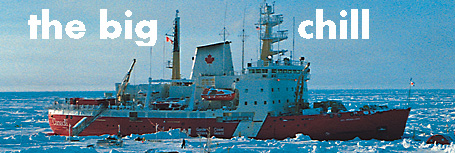

Advice for newcomers to the station includes warnings about polar bears. We are told that polar bears can run 55 miles per hour. They are aggressive with little or no fear of human beings. When they charge you, they mean it (other kinds of bears--even grizzlies--will make an initial rush or two but may back off without actually attacking).
Part of the job of those working on the bridge is to scan the area for bears. With adequate warning, confrontations can be avoided in which an animal or a human could be hurt. We're all instructed that:
Anyone leaving the ship needs to alert the bridge. That individual, or someone in their party, must have a radio and a rifle.
Five blasts of the ship's horn means a polar bear has been spotted. Anyone working on the ice, whether in a research hut or not, must return to the ship. First, however, one must use a radio or look around to ensure a bear isn't in the immediate vicinity.

UW's Dean Stewart, one of Heiberg's logistics team members, carries both a radio and rifle when we head out to tour the ice. We quickly happen upon an unexpected piece of "safety equipment" on our foray: a rowboat sitting on the ice. Stewart explains that boats are needed to cross "leads," places where the ice pulls apart, exposing open water and sometimes isolating parts of the station from the ship.
The surface of a lead can quickly refreeze. It is safe to cross once it is three inches thick, Stewart tells me, something he has learned to determine by tapping the ice with a long-handled crowbar and listening to how solid it sounds.
(As I walk across 20 feet of new ice - with something like 11,000 feet of frigid ocean water under my feet - I think real hard about this business of the ice sounding right.)
Leads, like polar bears, can be dangerous if one isn't aware of the ever-changing conditions. Heiberg recalls a 40-foot-wide lead that opened up and healed over near the ship last winter. The new ice was easily a foot thick and had been solidly frozen for days when Heiberg crossed it for a task that took five minutes. Turning to walk back to the ship, he noticed two ridges a foot and a half tall had formed like "petrified waves" along the length of the lead. He realized that the ice was under pressure and decided against walking across that ice back to the ship. Moments later the petrified waves snapped, sending water and shards of ice flying.
Total Meltdown? Ice Cap Future in Question
Send a letter to the editor at columns@u.washington.edu.